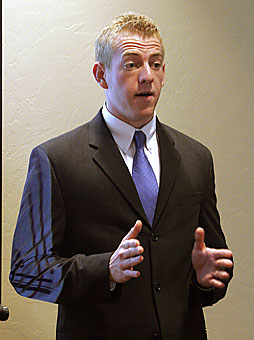 |
|
MATT ROBLES / Arizona Daily Wildcat
|
ASUA President Alistair Chapman announces the student leader proposed tuition increase at the Student Union Memorial Center.
|
|
|
By Jennifer Amsler
Arizona Daily Wildcat
Tuesday, February 15, 2005
Print this
Student leaders released their tuition increase proposal and pledged to target class availability problems and fund graduate assistant tuition reimbursement with the new revenue, an alternative to the tuition hike administrators recommended.
The Associated Students of the University of Arizona announced their proposal yesterday, a plan that calls for an 8 percent, or $320, increase in tuition for resident students and a $405 increase for non-resident students.
Tuition for all graduate students, according to the proposal, would increase $430.
The largest percentage increase would be for resident students, which includes an 8 percent increase for undergraduates and a 10.12 percent increase for graduate students.
Tuition for out-of-state students, both undergraduate and graduate, would increase slightly more than 3 percent, according to the ASUA proposal.
Alistair Chapman, ASUA president, said increasing tuition is necessary to compensate for the continuous decline in state funding.
"The theme of the proposal embodies financial pressures the university is facing," Chapman said.
According to the Chronicle of Higher Education, Arizona contributed $28 million to higher education, which is $112.2 million lower than the national average. Currently, Arizona has the third-highest decline rate nationally from state contribution to higher education, said Ryan Patterson, Arizona Students' Association director.
Chapman said the state money the university does receive is "restricted," meaning it can only be put toward specific programs.
Since tuition dollars are unrestricted, they provide the university with financial flexibility and put money toward programs in need.
"The goal of any administrator is to have as many unrestricted dollars as possible," Chapman said.
Likins' proposal includes a $60 mandatory fee for information technology, but Chapman said ASUA officials are against the fee because students did not indicate this was one of their top concerns.
ASUA analyzed the results from an Internet survey distributed to all students to find how they wanted to see their tuition dollars spent. More than 2,000 students participated in the online survey, but ASUA leaders say it still reflected the student body as a whole.
"We wanted to get a broader look of campus and see what student needs are," Chapman said.
ASUA leaders largely took into account survey responses when writing the final draft of the proposal, Chapman said.
Blake Buchanan, ASA delegate, said because every student was invited to complete the survey, it was less biased than a forum or other kinds of communication avenues.
Buchanan said the survey results were "very, very similar to the actual student population."
Results from the survey showed the No. 1 concern among undergraduates was class availability, which was also a major issue from earlier results when an outside agency conducted a survey in 2003 to evaluate student retention.
ASUA's tuition increase would allot $30 per student from the tuition increase to hire more instructors and teaching assistants, along with providing students with non-traditional ways to complete requirements, such as Internet courses and distant learning opportunities. The $30 from each student would generate about $512,000 after aid is deducted.
The student tuition proposal would also fund a 10 percent increase in graduate tuition remission, which would boost graduate assistant tuition waivers to 70 percent.
Regents will review and vote on the proposals during their March meeting, and Chapman said he has already spoken with two regents about the ASUA proposal.
In addition to gaining regent and student input, Chapman spoke with deans regarding registration problems, which gave student leaders "a foundation for how to approach the proposal."
-Natasha Bhuyan contributed to this report.
